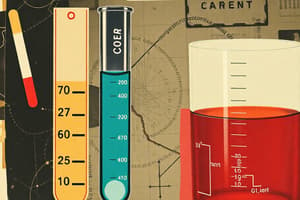Podcast
Questions and Answers
Which carbohydrate is classified as a di-saccharide?
Which carbohydrate is classified as a di-saccharide?
- Fructose
- Starch
- Glucose
- Maltose (correct)
What is the purpose of the Molish test?
What is the purpose of the Molish test?
- To analyze aromatic compounds
- To detect the presence of fatty acids
- To determine the presence of carbohydrates (correct)
- To identify reducing sugars
What color indicates a positive iodine test for starch?
What color indicates a positive iodine test for starch?
- Blue (correct)
- Violet
- Green
- Pale yellow
Which of the following tests specifically indicates reducing sugars?
Which of the following tests specifically indicates reducing sugars?
Which reagent is used in Tollen's Test to identify reducing sugars?
Which reagent is used in Tollen's Test to identify reducing sugars?
During the Rapid Furfural Test, what does a violet color during boiling indicate?
During the Rapid Furfural Test, what does a violet color during boiling indicate?
In the Osazone Test, what indicates the presence of monocarbohydrates?
In the Osazone Test, what indicates the presence of monocarbohydrates?
Which of the following sugars is a non-reducing sugar?
Which of the following sugars is a non-reducing sugar?
Which test involves the addition of NaOH and indicates reducing sugars?
Which test involves the addition of NaOH and indicates reducing sugars?
What is the role of the paper moistened with aniline acetate in the Furfural Test?
What is the role of the paper moistened with aniline acetate in the Furfural Test?
Flashcards are hidden until you start studying
Study Notes
Carbohydrate Classification
- Carbohydrates are aliphatic organic compounds that do not contain acidic groups.
- Classified into three categories: monosaccharides, disaccharides and polysaccharides.
- Monosaccharides are simple sugars like glucose and fructose.
- Disaccharides are made up of two monosaccharide units, such as lactose, maltose and sucrose.
- Disaccharides can be categorized as reducing or non-reducing sugars.
- Polysaccharides are complex carbohydrates formed by many monosaccharide units, like starch.
Molish Test
- A general test for carbohydrates.
- A violet ring forms at the interface of two liquids when α-naphthol and concentrated sulfuric acid are added to a carbohydrate solution.
- The violet color spreads throughout the solution after shaking.
Iodine Test
- Detects the presence of starch.
- A blue solution indicates a positive test for starch.
- A pale yellow solution indicates a negative test for starch.
Fehling's Test
- Detects the presence of reducing sugars.
- A brown or reddish-brown solution after boiling indicates a reducing sugar.
- No color change indicates a non-reducing sugar.
Tollen's Test
- Tests for reducing sugars.
- A silver or grey precipitate forms when the solution is heated in a water bath, indicating a reducing sugar.
- No precipitate indicates sucrose.
Osazone Test
- Differentiates between monosaccharides and disaccharides.
- Yellow crystals formed while heating indicate monosaccharides (e.g., glucose, fructose).
- Yellow crystals formed after heating indicate disaccharides (e.g., lactose, maltose).
Rapid Furfural Test
- Differentiates between glucose and fructose.
- A violet color appearing during boiling indicates fructose.
- A violet color appearing after boiling for two minutes indicates glucose.
Furfural Test
- Differentiates between glucose and fructose.
- A yellow color on aniline acetate paper inserted at the top of the tube indicates glucose.
- No change in color indicates the presence of fructose.
Studying That Suits You
Use AI to generate personalized quizzes and flashcards to suit your learning preferences.




